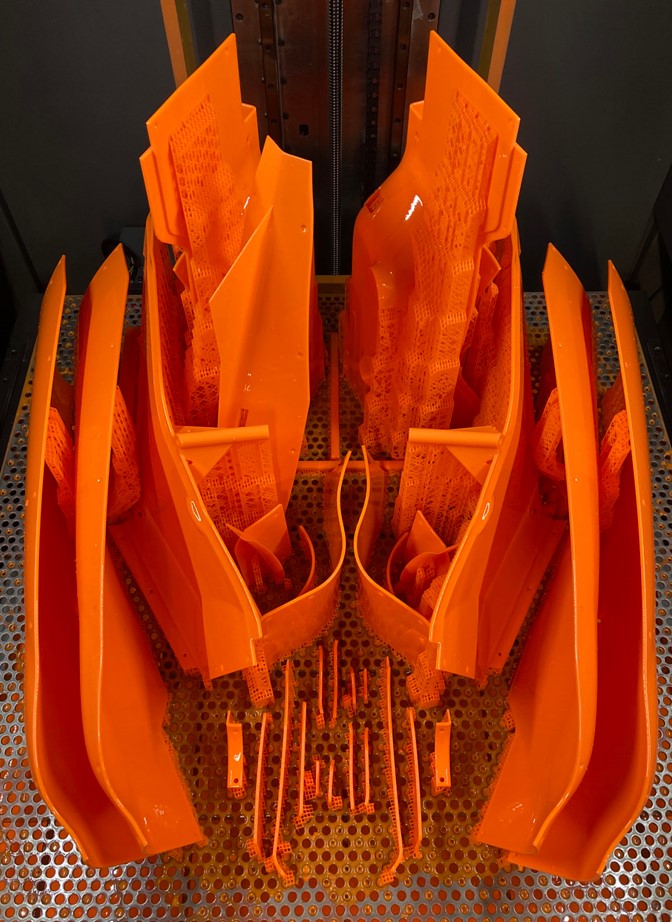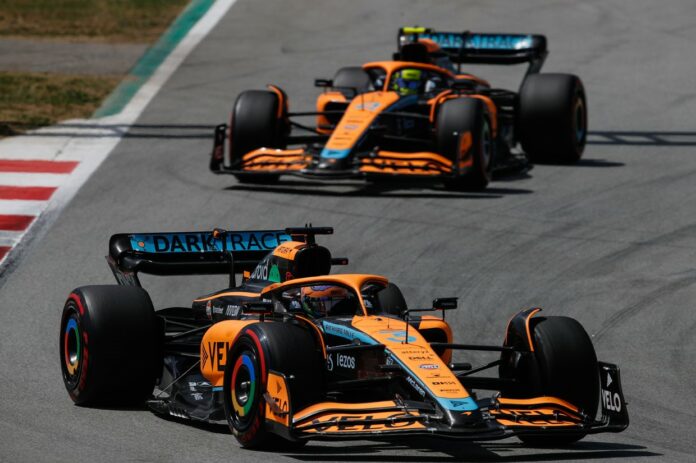Formula One expert McLaren Racing addresses demanding requirements in terms of time and budget from the FIA by 3D printing tens of thousands of parts. The engineering team would currently produce up to 9,000 parts per year across numerous front and rear wing programs, as well as large parts of the side bodywork and top-body.
They report big strides in optimizing vehicle aerodynamics during wind tunnel testing thanks to the accuracy of the parts produced using AM. Part production time has also been dramatically reduced. Large parts like scale model top-bodies for instance, could be produced in as little as three days.
At its base in Woking, UK, McLaren hosts a fleet of in-house printers that serve for the manufacturing of all aerodynamic parts. Their production environment integrates metal 3D printers and stereolithography processes. The latter are the Neo®800 stereolithography 3D printers from Stratasys.
Using in-house 3D printers brings a lot of advantages on the table: it enables to save costs on subcontractors and the associated quality assurance QA process. This is currently an ideal situation because with the sport facing uncertain times and no income coming in during Covid, the FIA decided to bring the budget cap down from $175 million to $145 million for its first year of operation in 2021, then down to $140 million for 2022 and $135 million in 2023.
With the SLA especially, the team can save considerable time, and save on costly metal material by not wasting large amounts of swarf removed from the subtractive machining process.
Wind tunnel testing remains a primary application here
“Stereolithography technology and the materials have evolved – changing the way we use it”, explains Tim Chapman, Head of Additive Manufacturing at McLaren Racing. “We do not just manufacture prototypes anymore; we now produce many full-scale components and full-size tooling.”
One of the primary applications where McLaren sees the most value with its Neo800s is for wind tunnel testing. The team uses 60% scale models to optimize the aerodynamic package and find more downforce – which provides more aerodynamic grip – and balance the front and rear aerodynamic loads on the car.

“Wind tunnel testing is still the gold standard when assessing how every surface works together, either as an assembly or as a complete car,” explains Chapman. “Our Neo series of 3D printers have helped us to dramatically reduce the lead times of our aerodynamic wind tunnel components and projects.”
The team prints parts using the Somos® PerFORM Reflect resin material, which was specifically developed for wind tunnel models. It creates strong, stiff parts that take 30% less time to post process.
Chapman continues: “We find the high-definition components from our Neo machines require minimal hand finishing, which allows much faster throughput to the wind tunnel. In addition to speed, we can now produce wind tunnel parts with supreme accuracy, detail and surface finish, which has enabled our team to enhance testing and find innovative new ideas to improve performance. I cannot overstate how important these benefits are in Formula One, with super tight deadlines to deliver cars to the next race, and where the smallest design iteration can make all the difference between winning, losing or making up positions on the grid.”
Remember, you can post job opportunities in the AM Industry on 3D ADEPT Media free of charge or look for a job via our job board. Make sure to follow us on our social networks and subscribe to our weekly newsletter : Facebook, Twitter, LinkedIn & Instagram ! If you want to be featured in the next issue of our digital magazine or if you hear a story that needs to be heard, make sure you send it to contact@3dadept.com






